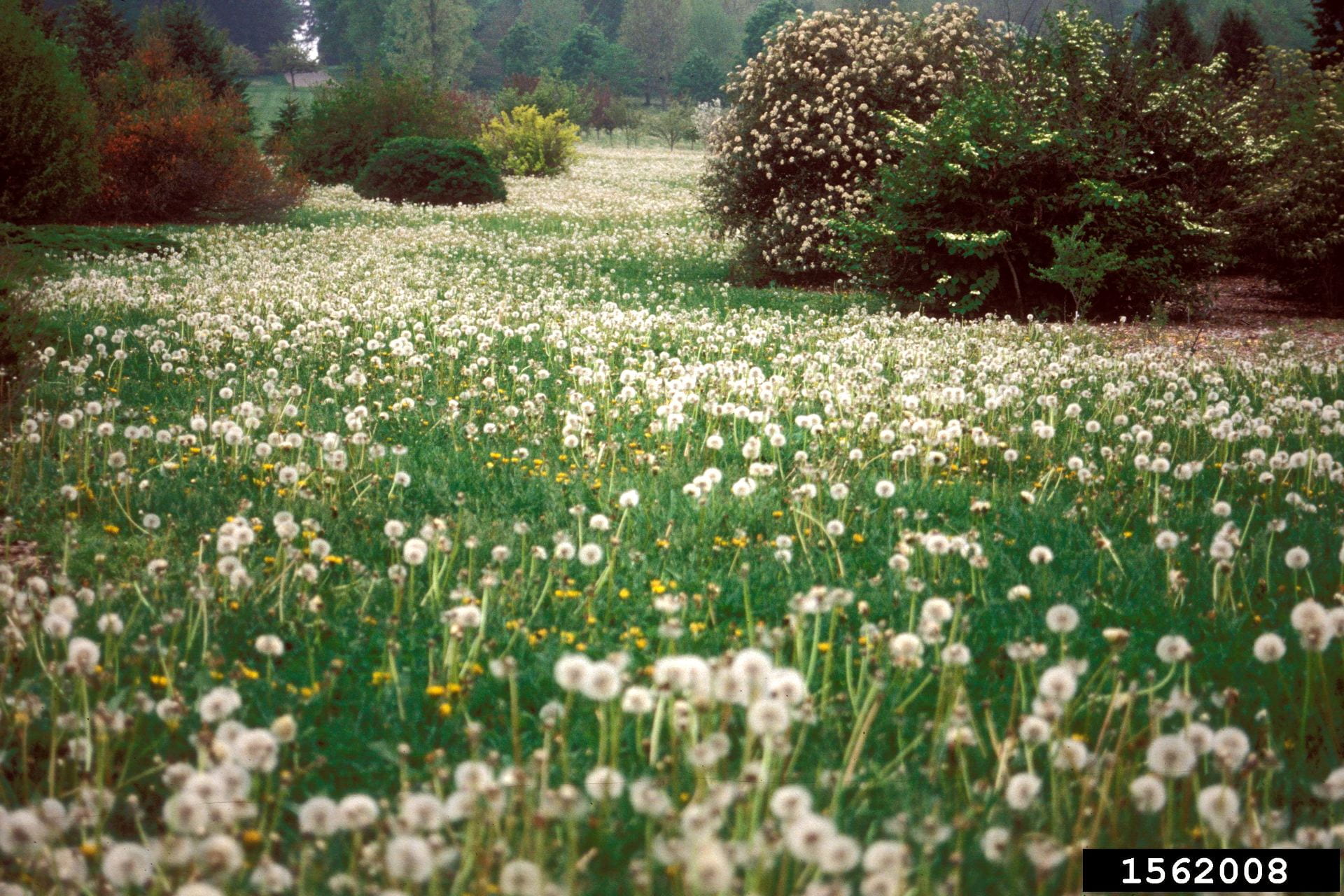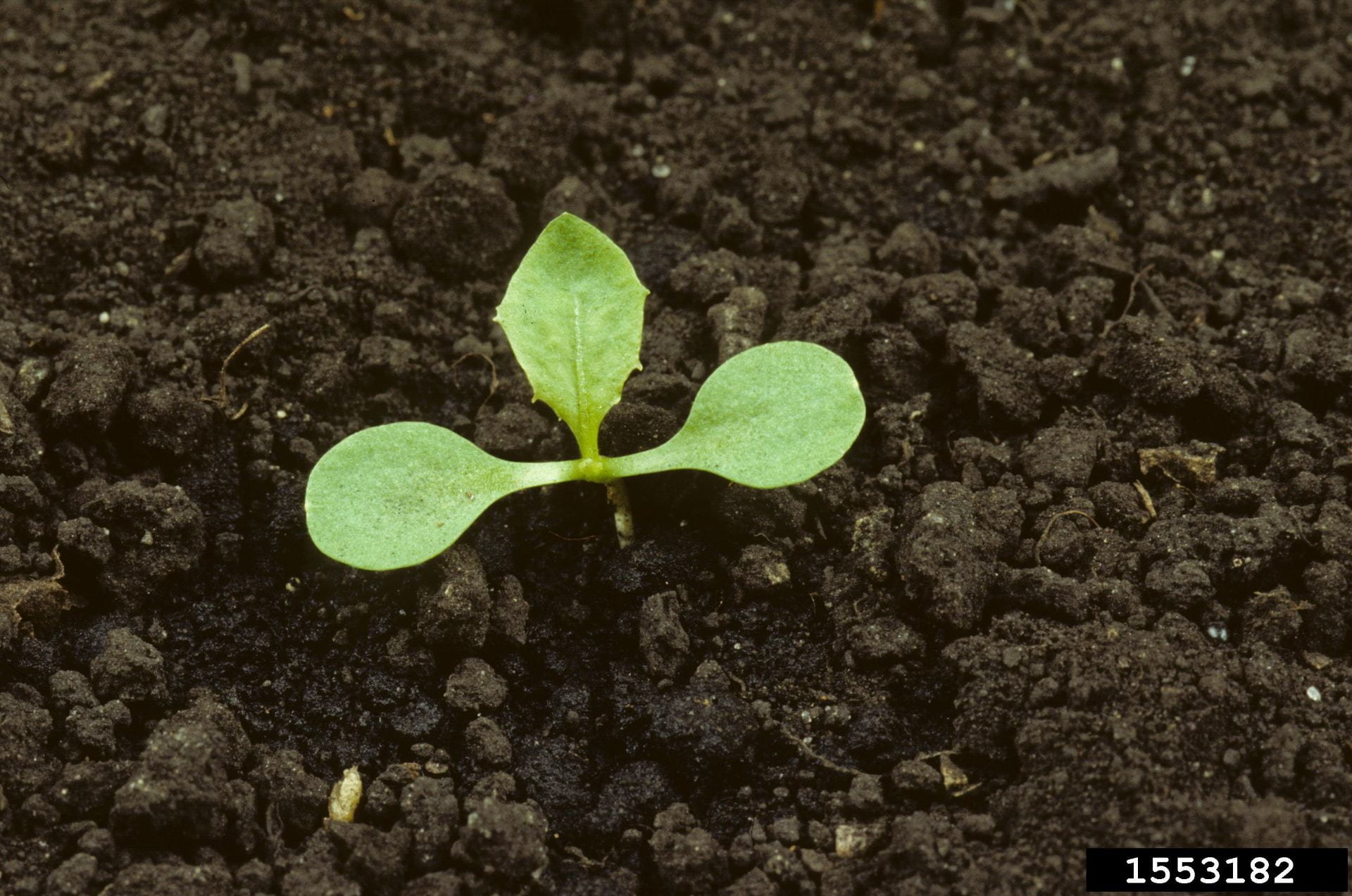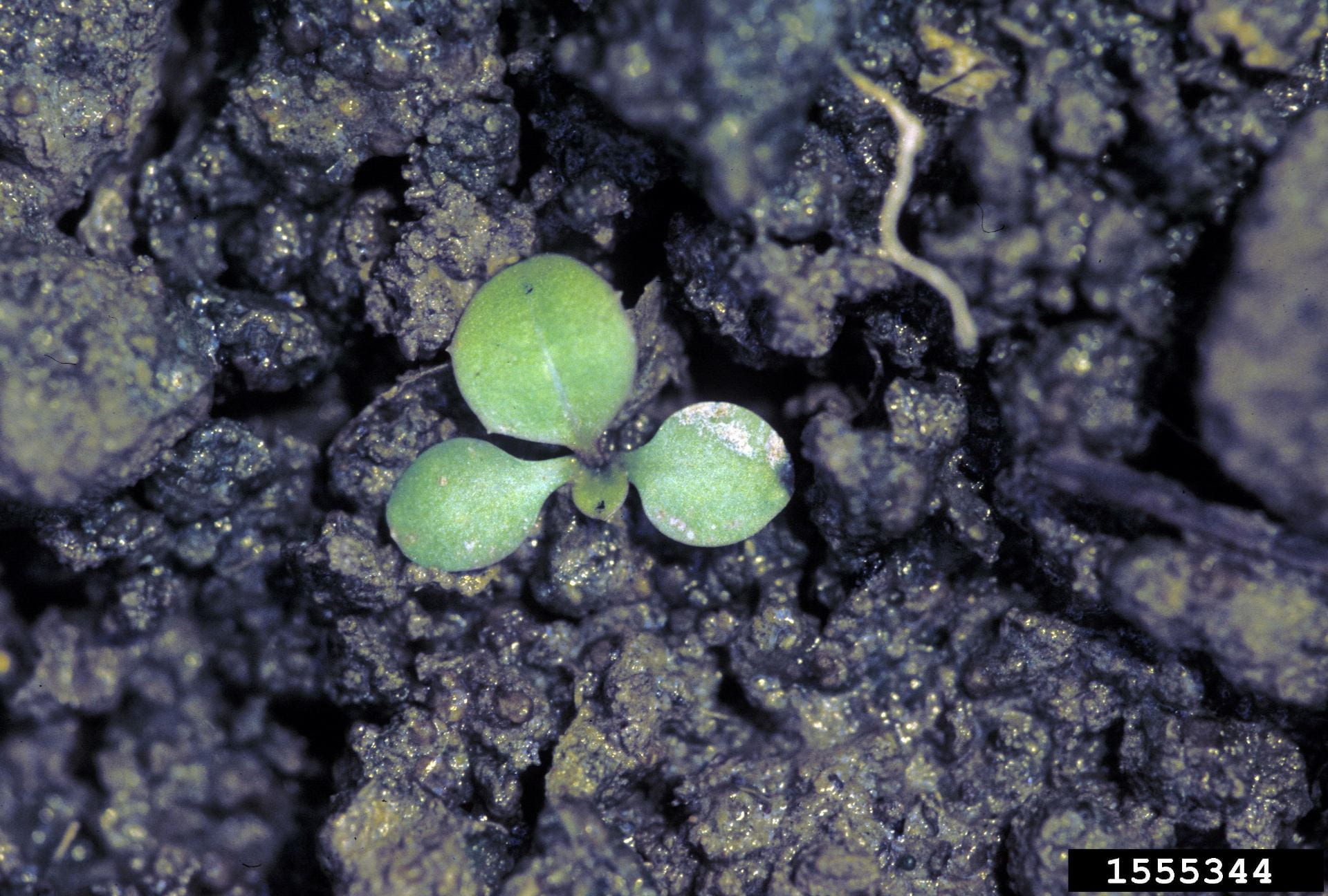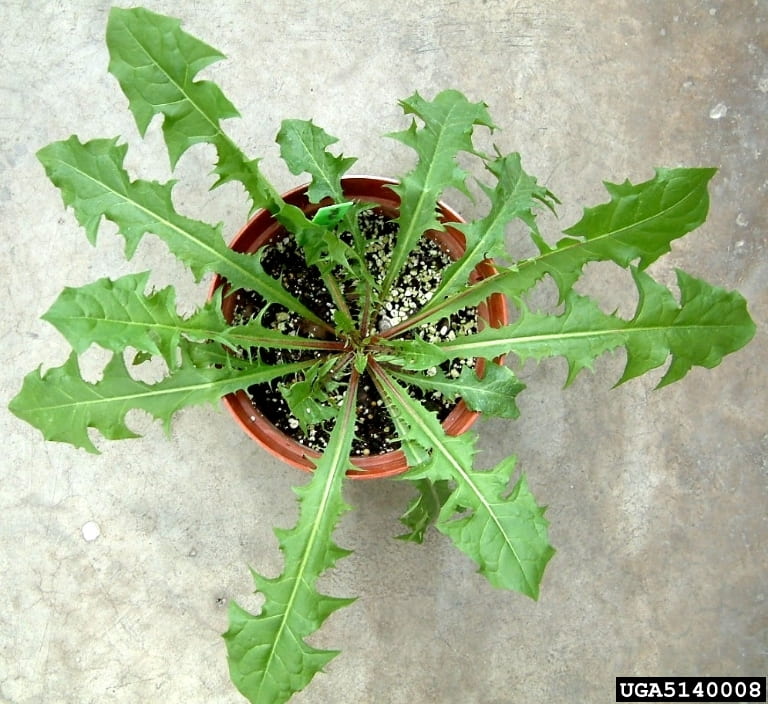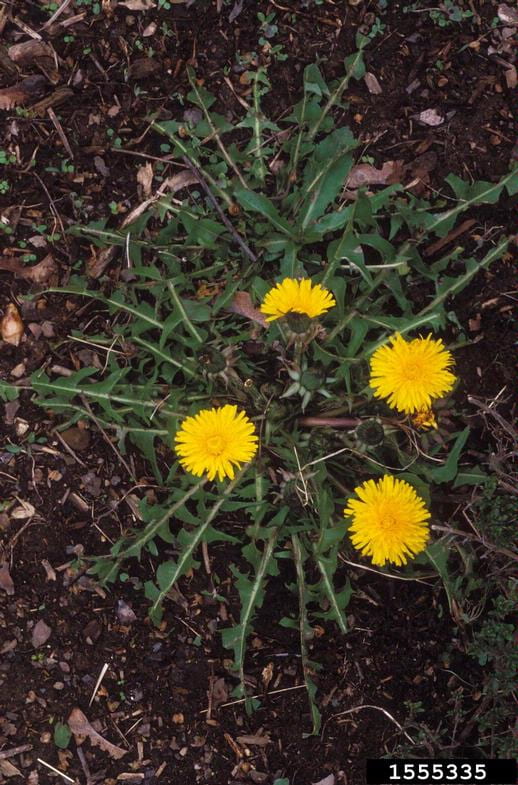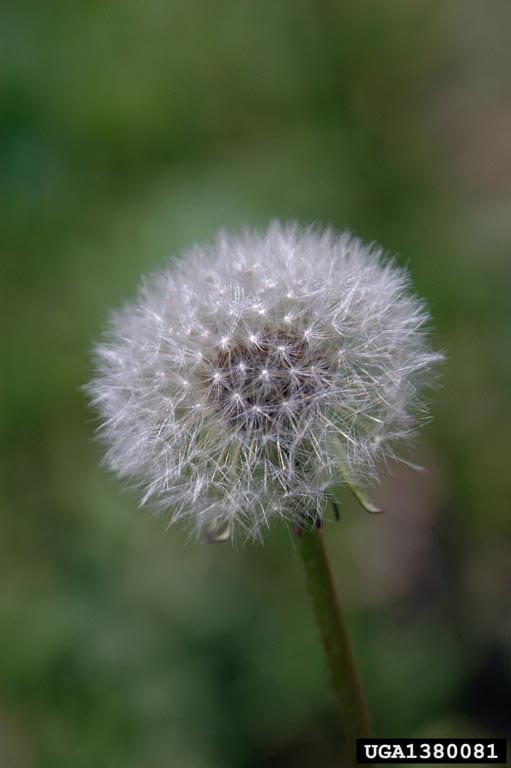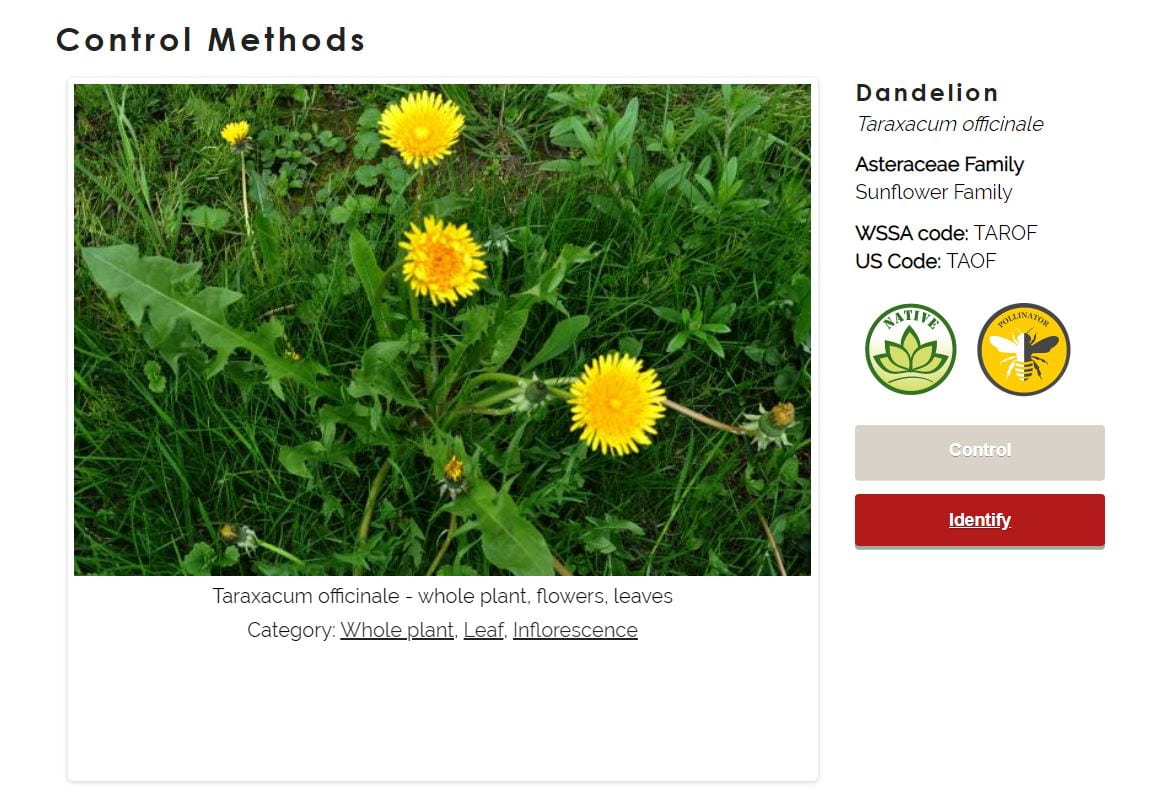Dandelion (Taraxacum officinale) is a ubiquitous perennial weed of turfgrass, orchards, nursery crops, alfalfa, and other perennial crops as well as landscaped areas. It is widespread across North America.
Identification
Seedlings: Dandelion cotyledons are yellow-green, smooth, and circular to oval or spatulate. Young leaves are hairless with a long petiole (leaf stem), green above and grayish-green below, and form a basal rosette of alternate arrangement. By the third true leaf, leaf margins are wavy with widely-spaced teeth.
Mature plant: The mature form of dandelion is a basal rosette with a thick, fleshy taproot that is easily broken and regrows readily if not fully removed. Leaves, flower stalks, and the taproot of mature plants exude a milky juice when cut open. Leaves have a few crinkled hairs on the upper and lower surfaces and widely-spaced teeth that point toward the leaf base. They are oblong to spatulate and 7.5-25 cm (3-10″) long. Each leaf’s terminal lobe is typically the largest, with segments decreasing in size and becoming more deeply divided toward the base. Dandelion reproduces by wind-blown seeds and through vegetative reproduction from broken taproot segments.
Flowers/Fruit: Flowers are produced from May to June, with a second bloom in autumn. The bright yellow flower heads are 3-5cm (1-2”) in diameter. The flower heards are solitary, at the ends of hollow, leafless flower stalks, 5-50cm (2-20”) long. The small, one-seeded fruits are yellow brown, 3-5mm (1/10-1/5”) long, and with a feathery pappus attached to a long stalk (8-10mm (3/10-4/10”)). Together, the fruit form a globe-shaped, grayish-white seedhead.
Management
Chemical control
Cornell University’s Turf and Landscape weed identification app provides recommendations for chemical management of dandelion.
Dandelion can be managed in apple orchards using pre-emergent and post-emergent herbicides (indaziflam, dichlobenil, flumioxazin, rimsulfuron and terbacil). See this ENYCHP Tree Fruit News article for more information.
Use this tool to look up the efficacy of herbicides on a particular weed species. For general guidance on weed control, get the latest edition of the Cornell Crop and Pest Management Guidelines.
Non-chemical control
Avoid high potassium (K) levels in the soil as dandelion does not hold up well against crops when the K is in short supply. Excessive liming (addition of lime to soil to control acidity levels) also promotes dandelion growth.
Dandelion can establish in alfafa after mowing, and has a tendency to increase during the alfafa phase of a crop rotation. Since alfafa can promote dandelion development, mowing alfafa during the dandelion’s flowering stage is an effective approach to management. Seeding forages on narrow spacing also reduces dandelion emergence and development.
Moldboard plowing can help manage intense dandelion infestiations because it buries the root crown deep in the soil; inversion of the roots decreases successful regrowth from small roots. Frequent tine weeding can remove new seedlings, and mulch can reduce successful establishment.
See A Grower’s Guide to Organic Apples from Cornell for non-chemical weed control options in apple orchards.
Climate Change and Management
Dandelion produces more seeds, larger seeds and pappi under elevated CO2 levels. Larger seeds have a higher germination rate, leading to quicker establishment of the offspring.
# of studies referenced in this section: 2
References
Uva R H, Neal J C, DiTomaso J M. 1997. Weeds of the Northeast. Book published by Cornell University, Ithaca NY. The go-to for weed ID in the Northeast; look for a new edition sometime in 2019.
Organic management suggestions are from Dr. Charles Mohler of Cornell University. Look for an upcoming book from Dr. Mohler on ecological management of weeds, from Cornell University Press.
Cornell University’s Turfgrass and Landscape Weed ID app. Identification and control options for weeds common to turf, agriculture, and gardens in New York; uses a very simple decision tree to identify your weed.
University of California Agriculture and Natural Resources, Statewide Integrated Pest Managemnt Porgram, 2018. Pests in Gardens and Landscapes- Dandelion.
All images are included from Invasive.org. Offers an extensive online library of images for invasive and exotic species of North America.
Basedow, M and L Sosnoskie. 2020. Strategies for Dealing with Pesky Perennial Weeds. Article published in the April 2020 issue of Tree Fruit News. Covers control of yellow nutsedge, Canada thistle, field bindweed, and dandelion in apple orchards.
Peck, G M and I A Merwin. A Grower’s Guide to Organic Apples. Covers organic weed control methods for organic apple orchards.
Breth, D I and E Tee. 2016. Herbicide AI by Weed Species. This tool allows you to look up the efficacy of an herbicide active ingredient on a particular weed species.
McPeek, T.M. and Wang, X. (2007) ‘Reproduction of dandelion (taraxacum officinale) in a higher co2 environment’, Weed Science, 55(4), pp. 334–340. doi:10.1614/ws-07-021.
Williams, A.L. et al. (2007) ‘Warming and free‐Air Co2 Enrichment Alter demographics in four co‐occurring grassland species’, New Phytologist, 176(2), pp. 365–374. doi:10.1111/j.1469-8137.2007.02170.x.

